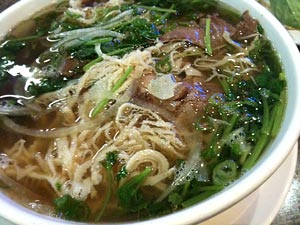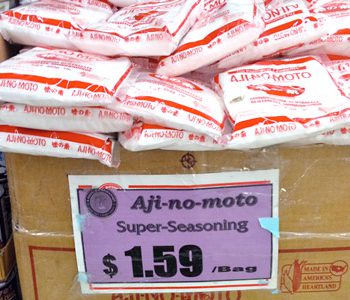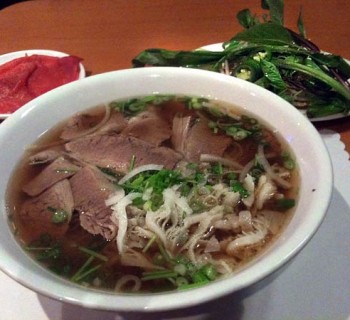 Updated 03-14-15. Pho recipes come in great numbers around the Internet and you can find them easily using your favorite search engine. Some pho recipes are penned by well-known chefs and culinary experts, while others are shared by experienced pho cooks and private citizens. The most popular, however, are the ones written by chefs and published in various cookbooks. So here's a collection of the top pho recipes you can find on the Web.
Updated 03-14-15. Pho recipes come in great numbers around the Internet and you can find them easily using your favorite search engine. Some pho recipes are penned by well-known chefs and culinary experts, while others are shared by experienced pho cooks and private citizens. The most popular, however, are the ones written by chefs and published in various cookbooks. So here's a collection of the top pho recipes you can find on the Web.
It should be pointed out that this list is different from the list already published as "Ten Pho Recipes from Around the Web," which was more of a random sampling of pho recipes at the time I wrote it. Many are not as authentic as they should be, and two of those ten are very good, solid recipes by two of the most respected experts in Viet cuisine. I published that article in a rush, so now with a little more time and effort put into it, here are my pick of must-have top pho recipes.
Top Beef Pho (Phở Bò) Recipes
| Pho Author/Chef Name | Webpage with Pho Recipe | Pubished | Rank by LovingPho |
|---|---|---|---|
| Nicole Routhier | recipesource.com | 1999 | 1 |
| SteamyKitchen | steamykitchen.com | 2006 | 1 |
| Mai Pham | epicurious.com | 1995 | 1 |
| Didier Corlou | vietworldkitchen.com | 2002 | 1 |
| Andrea Nguyen | vietworldkitchen.com | 2002 | 1 |
| Wandering Chopsticks | wanderingchopsticks | 2006 | 1 |
| eatdrinknbmerry | eatdrinknbmerry | 2005 | 1 |
| Kevin Young | food.com | 2000 | 2 |
Top Chicken Pho (Phở Gà) Recipes
| Pho Author/Chef Name | Webpage with Pho Recipe | Published | Rank by LovingPho |
|---|---|---|---|
| Andrea Nguyen | vietworldkitchen.com | 2002 | 1 |
| eatdrinknbmerry | eatdrinknbmerry | 2005 | 1 |
| Charles Phan | foodandwine.com | 1998 | 1 |
| Wandering Chopsticks | wanderingchopsticks | 2006 | 1 |
Top Vegetarian Pho (Phở Chay) Recipes
| Pho Author/Chef Name | Webpage with Pho Recipe | Published | Rank by LovingPho |
|---|---|---|---|
| The Gastronomer | gastronomyblog.com | 2006 | 1 |
| Emily Ho | thekitchn.com | 2010 | 2 |
I ranked the recipes using simple numerical ratings of 1, 2, 3, etc. with 1 being best. I left many recipes at the same level because I feel that, once they achieve what they set out to do (that is, to show a neophyte how to make pho themselves for the first time,) there is no point of picking one over the other. They are all good. They have variations among them, but all the basics are there and you can't go wrong with any of them.
For the beef pho, the recipe with rating of 2 did have bones in it but did not parboil the bones, making the broth less ideal and "clean" although the instructions did say to "scrape" and discard the scum. Plus it uses bay leaves and fennel seeds which may get the taste a little off for those who know pho well. I gave it one level down but it is a good recipe.
Chicken pho is relatively very easy to make, and the chicken pho recipes listed here are all pretty solid. They all get 1's.
For the vegetarian pho, I would prefer fresh vegetables, but these 2 are very good vegan pho recipes using pre-made vegetable stock. The Gastronomer gets top billing here for its great technique on the vegetarian "meat" and use of leeks in the broth. There are still other recipes using fresh vegetables, but I felt the vegetables used in those recipes really do not lend to the right flavor to make pho and may even be a little off-taste. Of course, a vegetarian dish can use any vegetable. But because it is pho and not just a vegetable soup, the flavor profile has to be correct. Anyway, I'll discuss a little more on this subject in another post.
The bottom line?
As you can see, many of these are great pho recipes. As we all know, it's all in the pho broth, so concentrate on how to make the broth. Once you've got the broth, the rest is easy and will just fall into place. Check 'em all out, pick one, make some and enjoy.
 But what is the REAL bottom line? It is this: Just pick one of these recipes that strikes your fancy and go with it. After the first or second time using it, I guarantee you will want (and know how) to experiment to get what you really want, by adjusting or adding ingredients. You'll have a feel for what each ingredient contributes to the broth's awesome and unique flavor, and will be able to make the changes to fit your taste. Remember, these recipes are only a staring point. Beyond that, you should be able to make the pho that you enjoy. You may incorporate some other ingredients or try out a "secret" element you've read about or heard from someone. You don't really need to find the "best" recipe; because it doesn't exist. You just need to start making pho. Whatever you do, don't forget to try that pho chay. Delicious!
But what is the REAL bottom line? It is this: Just pick one of these recipes that strikes your fancy and go with it. After the first or second time using it, I guarantee you will want (and know how) to experiment to get what you really want, by adjusting or adding ingredients. You'll have a feel for what each ingredient contributes to the broth's awesome and unique flavor, and will be able to make the changes to fit your taste. Remember, these recipes are only a staring point. Beyond that, you should be able to make the pho that you enjoy. You may incorporate some other ingredients or try out a "secret" element you've read about or heard from someone. You don't really need to find the "best" recipe; because it doesn't exist. You just need to start making pho. Whatever you do, don't forget to try that pho chay. Delicious!
For additional help, read my post on Easy Fixes to Common Homemade Pho Problems, where I provide additional helpful tips to either reinforce or elaborate on the instructions from many of these recipes. Follow those and you will have a great pot of homemade pho to feed a whole bunch of hungry family and friends.
Good luck and let me know how I can help.
By the way, a decent alternative to cooking pho broth for hours on end is with Quoc Viet Foods’ Pho Soup Base.
And one last thing, please take this poll.
Originally posted 09-12-09.




Hi, I applaud your blog for informing people, very interesting article, keep up it coming 🙂
these places sound great. Maybe I’ll try it sometimes. But since I discovered this insanely good and easy Pho product called Happy Pho that I can use to make pho from scratch in 15 mins I’ve found it hard to motivate myself to cook Pho. It’s by a comapny called Star Anise Foods and the founder used a secret family recipe from her grandparents’ restaurant from Nam Dinh where Pho came from to make the spice packet in the kit. You get a spice packet with all natural and organic spices, and brown rice noodles and just have to add some chicken or beef broth and fresh herb and mushroom or meat if you like. I was skeptical at first but now I completely LOVE them. I got mine from Noe Valley Whole Foods, you can get them online at amazon.com — check them out here http://staranisefoods.com/find-us.aspx
Hi Yen Nguyen: Thanks for stopping by and share your experience about Happy Pho, and I’m glad you love them.
I’m going to sound critical but that’s my job 😉 plus I’m all about the good authentic pho so I should be critical about anything that is not but tries to be.
The sales and marketing materials looks and reads very good, though I would not serve the lime wedge right in the bowl as some of the photos suggest. The product looks and sounds like another instant-type noodle, albeit with healthier ingredients compared to the typical instant pho or instant noodle.
I would question the link to pho Nam Dinh, however, as pho Nam Dinh is very specific in the way it’s prepared, and its quality depends entirely on the love of the Nam Dinh chef to make it the traditional way. I’ve seen many attempts to modernize Vietnamese pho to make it convenient for the American or other markets outside of Vietnam, but so far I’ve seen only one succeeded for very specific reasons.
Furthermore, the company’s website uses lots of images taken from the streets and markets of Vietnam. While this does give an aura of authenticity, I’m sure Happy Pho does not taste anywhere close to those sold at pho stalls depicted in the photos. (I’m a little picky here, I admit.)
So let me get this right. Here’s what I can gather from the information from Amazon and Star Anise Foods website: Each pack has 6 4.5-oz BOXES (2 servings per box). This makes a pack containing 12 servings. At $32.90 from Amazon, each serving costs just under $2.75, not including shipping. This is on par with most instant noodles, the better than average kinds. So if someone if looking for something healthy (as claimed by the maker of Happy Pho) and quick, this may do better than another instant pho. Or this may be a good vegetarian pho alternative. I would be very curious to see the nutritional labels on this product.
Overall I think this shouldn’t be called pho. It looks more like another kind of hủ tiếu to me. I’ll try it when I have a chance.
Hey Cuong Huynh
Thank you so much for talking about Happy Pho in your blog. It’s really a tasty, healthy version of Pho and as someone who grows up eating Pho I will say that it tastes just as good as the real thing. But really, I’d love for you to try our product and see for yourself 🙂 You can find the nutrition facts here. Our product only has brown rice, spices, water, salt and a touch of green tea, and nothing else. You can see our nutrition facts here http://staranisefoods.com/our-products.aspx
Have a great day
Thao
Hi Thao and Yen Nguyen: Enough of your marketing spiel. Just so we understand each other, LovingPho.com is not a vehicle for free marketing of your company and products. If you’d like to have your products reviewed by me, or place an ad on LovingPho.com, please send an inquiry through the contact LovingPho.com page. Future unsolicited promotion will be banned.
I love this site! I have a pho recipe of my own:
http://likethatscenefromrocky.blogspot.com/2011/04/vegan-challenge-day-1.html
Hi Elizabeth: Interesting vegan pho recipe. I would suggest preparing the noodles last after the broth is done. You don’t want the cooked noodles sitting in the bowls for more than a few minutes, certainly not more than 5 minutes, otherwise it will cake or solidify. Also as a matter of sequence, if the chicken started out uncooked, then you’ll want to cook it with the broth from the beginning to get the spices into the chicken too. This also allows you to skim any froth resulting from dropping raw chicken into hot broth. Then the chicken and bell peppers should be taking out of the broth and sliced or whatever you want to do to them. The serving sequence should have all ingredients arranged over the noodle in the bowl, and hot broth ladled over them all. Finally, don’t put lime juice in the cooking broth pot! Rather, squeeze it into your bowl just before you eat. Enjoy.
I appreciate the recipes! 🙂
When I was living in the San Francisco area, there was a restaurant in Palo Alto that made an incredible spicy-hot pho ga with pineapple. I have looked all over the Internet for such a thing, but have never found it So I was wondering if you experiment with different flavors in your pho ga. Would you be interested in trying to make it? Or do you consider yourself more of a purist?
Hi Meredith: Umm, I guess I’ll stay away from spicy-hot pho ga with pineapple. Even if I’m creative enough to make pho ga with pineapple I wouldn’t call it “pho” to confuse my patrons, especially those who are not familiar with the dish. I would call it “spicy chicken noodle soup with pineapple,” or something similar. Yes, by the flavors of my articles on this blog, you can consider me a pho purist. But I’m not necessarily an extremist 😉 To me, authenticity has certain boundaries. Outside of these boundaries, the creative chefs should identify his new creations as “fusions” of the original dish.
Oddly, this was a pho restaurant! Maybe the recipe was a family secret…
If you want to try a “fusion” or a spicy pineapple chicken soup sometime, I think the heat may have come from Sriracha Hot Chili Sauce. Not positive, but there you go. 😀
Yes I’ve seen pho restaurants do all kinds of new things to get your money. When it comes to getting paid, restaurateurs will oblige to the clients’ requests, especially when it’s so easy to please. The thinking is, the customer asks for it, so why fight it and try to “educate” her that what she wants doesn’t really exist?
I’m sure there are many ways to kick up the heat in any soup. For me, I’ll just have mine the good old traditional way. That pineapple still bothers me a little though… 😉
Dear Cuong,
My girlfriend and I are avid pho eaters. Unfortunately we’ve had the pleasure of too many Pho restaurants and now cannot curb our appetite for more! I was hoping someone on this site may be of some assistance with a hidden recipe we are trying to figure out from one of the various restaurants. All of the Pho tastes fairly similar but each has it’s owns style. This one Pho place, (Pho 21) has the best broth EVER! It’s a brownish color (clear), but has the spices and almost a sweet hint taste to it. You can also smell a distinct smell when you open it. I want to say it’s like brown sugar or cinnamon but we can’t get enough of it. It’s not like sweet but has a hint of it which drives our taste buds nuts. We are trying to make our own broth at home, and want that aspect to our broth… any thoughts or suggestions? Thank you
-David
Hi David: It’s good that you can find a pho place that you like. With respect to duplicating what they put in their broth to serve you, I’d say that would take excellent detective work first and foremost. Other than that, luck or some midnight acquisition (stealing their recipe that is 😉 )
Joking aside, I do not know where to begin to help you, except that knowing the spices of pho broth being star anise, cinnamon, cardamom, cloves and coriander seeds, you may want to vary them to get something close to what you want. People add rock sugar, and to do pho broth right, you’d also want some good quality fish sauce. Also some umami (read MSG) is definitely not out of the question either. Outside of these “traditional” spices and ingredients, I’ve known some to add very unconventional ingredients that they claim to be family secrets, resulting in something palatable to many others. Still a few others, hoisin sauce for pho is one of the ingredients in their broth! Can you imagine that? So there you go David, your mileage may vary.
Have you read Andrea Nguyen’s post Pho Secret Ingredients: Dried Earthworms (Sa Sung)?
Or maybe you should apply for a job and work there for a while…
By the way, I wouldn’t say it’s unfortunate that you can’t curb your appetite for more pho. It’s a good thing!
/pho-ingredients-garnishes/ten-pho-recipes-on-the-web/. You mentioned on this link there are 2 very good pho recipes, whice 2 were you talking about? I’d like to try them myself
Must.Have.Pho: In the article Ten Pho Recipes from Around the Web, the 2 recipes I referred to are listed under the section called The Pros.
Hi Cuong,
I tried Pho in Phoenix, AZ last year and have been hooked since. Unfortunately, I relocated to a relatively small community in Minnesota and there is only one restaurant that serves Pho. While it is good, they don’t seem to do a good job of skimming the fat. I’m no health nut but I do have limits. It really bothers me more in the taste than anything.
So, I’m going to try making it at home. Of the recipes above, or others, can you give me your insight into a good recipe for a beginner? I’m a decent cook and the process doesn’t deter me.
Also – I love your site – I appreciate your efforts!
Dennis
@Dennis: Home-made pho for beginner, hmmm… I don’t think there is such a thing, but the good part is it shouldn’t matter. Here’s what I mean. To get your pho made right, you’ll only need two things: 1) A good set of instructions (recipes) and a good operator (you.) Andrea Nguyen, Didier Corlou and SteamyKitchen are excellent teachers with lots of experience in helping people make their own tasty dishes successfully. So your battle is half won right there. The rest, you’ll just have to follow their recipes as closely as you can with proper ingredients and techniques, and you’ll get it right every time. Good luck and have fun!
Can someone share with me how to prepare the beef? is it putting all different type of cuts (eg brisket, flank, tendon, fatty, and crunchy flank) into the broth and simmer? or cook/boil the meat separately? i’ve experienced either too hard and chewy meat with short time cooking or just too loose and the meat fall apart after long hours simmer with the broth 🙁
also, i found dried beef tendon in market. is it good to use it? and how to prepare it?
@sien: I don’t know which recipe you use, but it seemed any recipe should tell you what to cook and when. Anyway, based on what you listed there, I’d suggest the following sequence:
– Parboil the brisket, flank and crunchy flank, then rinse. Then your real broth cooking begin with boiling the water again and put these back in, then simmer over low heat.
– Add in the spices and flavoring per your recipe at the time they’re called for.
With respect to tendons and tripe, you want to cook them separately over intense heat to soften them. It may take longer time as well, depending on your cooking method. I’d recommend a pressure cooker for the tendons. For tripe, a simple pot of boiling water is all you need. Hopr this helps.
Personally, I’ve never tried dried beef tendon, and I’m not even sure what it is.
Hi Cuong,
Thanks for the reply.. and will try that.
By the way, I have bought a pho package from Vietnam and inside there is dried orange peel and also some dried herb root (Trần bì & Cam thảo).. are these some sort of special recipe? Too bad I can’t post the photo, else will post it here to share with everyone else..
Hi sien,
You may use a photo hosting service for your photo and provide a link here. Dried orange peel does not sound like anything traditional pho, nor do the other 2 items you mentioned. But I really can’t tell without seeing them. Sorry I can’t help you there, but do let us know how your pho turn out.
Please help to translate if you can see the photo…thanks
http://www.flickr.com/photos/sienhuat/8551405064/in/photostream
any one knows vietnamese? pls help to translate it to english on the photo..thanks
@sien: I can help translate but haven’t had the time yet, but here goes. The first part is a list of ingredients, in order, large star anise hồi (3g), small star anise hồi (3g), clove đinh hương (1.5g), cardamom thảo quả powder (1.5g), cardamom thảo quả (1.5g), trần bì (3g), coriander seeds ngò hột (3g), licorice cam thảo (1.5g), cinnamon quế (12g). I’m not sure what trần bì is [correction: trần bì is dried citrus peel, often orange, found in many Chinese drug/herb stores.] I don’t think pho needs this, but it may give some interesting flavors.
To make the broth: Use 1 bag of spice for pho broth (3og) boiled in 5 liter of water. Add shallots (hanh tim), daikon (cu cai trang), spice/flavoring, with 2kg of beef bone, simmer with 4 liters of water, then add 600g rare beef for 2 people.
This above is my best attempt to translate Vietnamese into English. Many instructions like this are written as one long sentence which you must figure out yourself. I think you can get the gist of it.
Personally, I think you might as well follow one of the more clearly written recipes pointed out in this blog post, instead of trying to follow what’s on the bag. Hope this helps.
thanks for the translation.. i’ve checked the package and all ingredients you’ve mentioned are there and only dried orange/lime peel you didn’t mentioned… so i guess trần bì is for that?
Strangely the package consists of licorice and dried orange peel.. licorice taste bitter though… some they add dried sea worm to the broth.. and some even add dried scallops to bring stronger flavour… anyone here got their own ‘secret recipe’ to the pho mind to share??? 🙂
@sien: Yes that must be trần bì. As you can see, people have many ways to give subtle flavors to the broth. In the end, it’s your own preference, economy and time that will dictate how you make your broth. I’m personally not a big fan of “secret ingredients” as they don’t do much for me. If one has secret ingredients making broth at home, it’s rarely made and is only enjoyed by a few. If a restaurant has secret ingredients, oftentimes it is something simple and probably inconsequential. I’ve heard of a few people using licorice and dried orange peel, but again, this is fine cooking at home. For large quantities, this gets expensive.
Yay! I’ve been craving good pho ever since we had some at a restaurant in New Orleans, and I’ve been wanting to make my own ever since. Thanks for all the tips!
@TERALYN PILGRIM: Not sure where you’re located, and while it’s true pho is getting deeper into every nook and cranny of North America, it’s still a challenge to find good pho. I’m sure you can make a decent pot of pho, as you seem to be someone who pays attention to details. And by the way, pho itself is also a symbol of frugality, efficiency, and making the best use of all the resources that you have. Enjoy!
Thank you @CUONG HUYNH for these suggestions. I’m excited to learn!